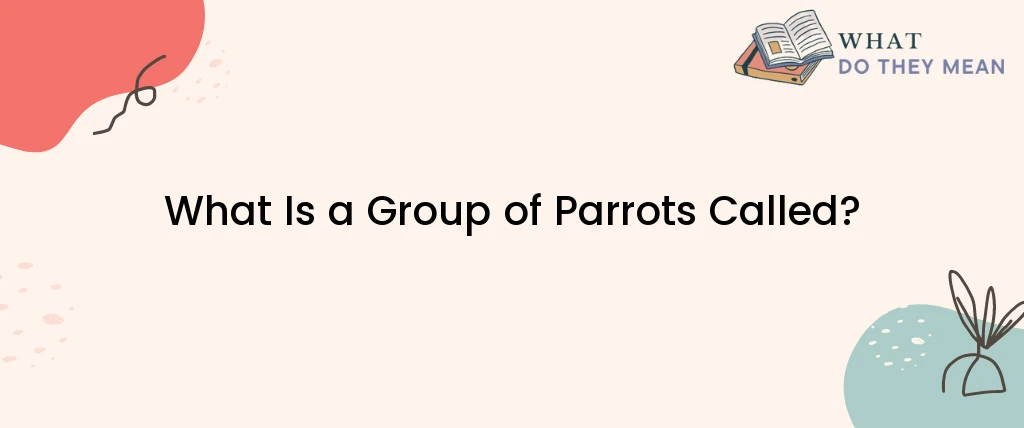Parrots are fascinating creatures known for their vibrant plumage, intelligent behavior, and remarkable ability to mimic human speech. These beautiful birds are often found in groups, displaying social behaviors that have captured the attention of bird enthusiasts worldwide. Have you ever wondered what a group of parrots is called? In this article, we will delve into the intriguing world of parrot communities and unveil the answer to this intriguing question.
Parrots, belonging to the order Psittaciformes, are known for their captivating colors, distinctive beaks, and intelligent nature. With their playful antics and ability to mimic sounds, they have become popular pets and subjects of scientific research. These birds have also intrigued ornithologists and animal behaviorists, who study their social dynamics and community interactions.
The Social Nature of Parrots
Parrots are highly social creatures, often forming close-knit bonds within their groups. They exhibit complex behaviors, including cooperative feeding, communal roosting, and shared parenting duties. Their social structure allows them to navigate their environment effectively, find food sources, and protect themselves from predators.
Group Terminology in Ornithology
In ornithology, the study of birds, various terms describe groups of different bird species. For example, a group of geese is called a “gaggle,” while a crow collection is called a “murder.” These collective nouns add a touch of intrigue to the avian world, and parrots have their own unique term for a group.
Understanding Parrot Communities
Parrots form communities comprised of multiple individuals that engage in various social activities. Depending on the parrot species and their habitat, these communities can range from small family groups to large flocks consisting of hundreds or even thousands of individuals. The size and structure of these groups can vary significantly.
Parrot Flocks: The Common Term
Regarding parrots, the commonly used term for a group is “flock.” A flock of parrots typically consists of several individuals congregating and interacting with one another. These flocks are known for their energetic and noisy nature, with parrots engaging in social behaviors such as grooming, playing, and foraging together.
Parrot Flock Behavior
Within a parrot flock, there is a sense of unity and cooperation. These birds communicate with each other through a variety of vocalizations, including squawks, screeches, and melodious calls. They exhibit synchronized movements, flying in formation and demonstrating impressive aerial acrobatics.
Fission-Fusion Dynamics in Parrots
Parrot flocks often exhibit fission-fusion dynamics, where the group dynamically splits and merges depending on various factors such as resource availability and environmental conditions. This flexibility allows parrots to adapt to changes in their surroundings, ensuring their survival and overall success as a community.
Differences in Group Sizes
The size of parrot flocks can vary greatly among different species. Some parrots prefer smaller groups, consisting of a few individuals, while others form massive flocks that gather in specific areas. For example, the monk parakeets of South America are known for building enormous communal nests and living in large colonies.
Vocalizations and Communication in Parrot Flocks
Parrots are renowned for their ability to mimic sounds, including human speech. Within a flock, vocalizations play a crucial role in communication. They use calls and specific vocal cues to coordinate group movements, warn others of potential threats, and establish social bonds. This vocal exchange fosters a sense of cohesion and cooperation among the flock members.
You may also like: What is a Group of Guinea Pigs Called?
Benefits of Group Living
Group living provides several advantages for parrots. It allows them to share information about food sources and potential dangers, increasing their chances of survival. Multiple individuals also protect predators, as the flock can collectively fend off threats. Moreover, social interactions within the group fulfill the birds’ social and emotional needs.
Parrots as Highly Social Birds
Parrots’ inclination towards group living stems from their natural instincts and social nature. They form strong social bonds, cooperate, and actively communicate with their fellow flock members. These traits highlight the importance of social interactions for the well-being of parrots in both the wild and captivity.
Conservation Concerns for Parrot Flocks
The preservation of parrot flocks is vital due to the threats they face in their natural habitats. Deforestation, illegal wildlife trade, and habitat degradation pose significant challenges to the survival of many parrot species. Efforts are being made worldwide to protect these charismatic birds and their habitats through conservation initiatives and legislation.
Parrots in Captivity: Group Interactions
In captivity, parrots often live in social groups within aviaries or large enclosures. These group interactions allow them to engage in natural behaviors like communal feeding and socializing. Providing an enriched environment and opportunities for social stimulation is crucial for captive parrots’ physical and mental well-being.
FAQs
Not all parrot species live in flocks. Some species, such as the Kakapo, are solitary and prefer a more independent lifestyle.
Parrots are long-lived birds; their lifespan can vary depending on the species. On average, small parrot species can live for 20 to 30 years, while larger species can live for 50 to 80 years or even longer with proper care.
Conclusion
In conclusion, a group of parrots is commonly called a “pandemonium.” These highly social birds form flocks that exhibit complex social behaviors and engage in cooperative activities. Parrots play significant roles in ecosystems and captivate humans with their intelligence and colorful plumage. If you’re considering a parrot as a pet, remember the importance of responsible ownership and supporting conservation efforts to ensure the well-being of these remarkable creatures.

As a researcher, I am curious and driven by the pursuit of knowledge. I approach my work with a critical eye, carefully evaluating sources and methods to ensure that my findings are accurate and reliable. Whether delving into scientific studies, historical records, or cutting-edge technologies, I am always seeking to expand my understanding and make new discoveries. I am dedicated to uncovering new insights and finding solutions to complex problems, and am driven by a passion for uncovering the truth.

